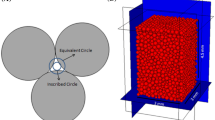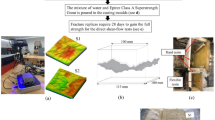Abstract
To study the effect of fracture properties on mechanical and fluid flow behavior of fractured rocks, we developed a micro-scale hydro-mechanical model. Modeling grains and studying their interactions are used to predict the mechanical response of digital rock samples. Fluid flow behavior is obtained through a realistic network model of the pore space in the compacted assembly. As a result of grain deformation and micro-crack development in a rock sample, the geometric description of the complex pore structure is regenerated to predict fluid flow performance of the rock sample using a dynamic pore network model. In our numerical model, the first step consisted of constructing a Berea sandstone sample. Then, fractures with different properties such as orientation, dilation angle, roughness, and cementing materials are introduced. Mechanical properties of the fractured sample are measured as functions of deformation by performing numerical triaxial tests. Applying a dynamic pore network provides a tool to investigate the important role of fracture parameters on transport behavior. Our results show that shearing along the fracture dilates the sample, and increases its permeability, which is a complex function of fracture mechanical properties.













Similar content being viewed by others
References
Al-Busaidi, A., Hazzard, J., Young, R.: Distinct element modeling of hydraulically fractured Lac Du Bonnet granite. J. Geophys. Res. Solid Earth. 110(B6) (2005)
Bakke, S., Oren, P.: 3-D pore-scale modelling of sandstones and flow simulations in the pore networks. Spe J. 2(2), 136–149 (1997)
Baria, R., Michelet, S., Baumgärtner, J., Dyer, B., Gerard, A., Nicholls, J., Hettkamp, T., Teza, D., Soma, N., Asanuma, H., et al.: Microseismic monitoring of the worlds largest potential HDR reservoir. In: Proceedings, 29th Workshop on Geothermal Reservoir Engineering (2004)
Bruno, M.: Micromechanics of stress-induced permeability anisotropy and damage in sedimentary rock. Mech. Mater. 18(1), 31–48 (1994)
Bryant, S., Cade, C., Mellor, D.: Permeability prediction from geologic models. AAPG Bull. 77(8), 1338–1350 (1993a)
Bryant, S.L., King, P.R., Mellor, D.W.: Network model evaluation of permeability and spatial correlation in a real random sphere packing. Transp. Porous Media 11(1), 53–70 (1993b)
Bryant, S.L., Mellor, D.W., Cade, C.A.: Physically representative network models of transport in porous media. AIChE J. 39(3), 387–396 (1993c)
Cipolla, C., Warpinski, N., Mayerhofer, M.: Hydraulic fracture complexity: diagnosis, remediation, and explotation. In: SPE Asia Pacific Oil and Gas Conference and Exhibition (2008)
Cundall, P.: The incorporation of fluid coupling into PFC (1999)
Cundall, P.A., Strack, O.D.: A discrete numerical model for granular assemblies. Geotechnique 29(1), 47–65 (1979)
Evans, K., Moriya, H., Niitsuma, H., Jones, R., Phillips, W., Genter, A., Sausse, J., Jung, R., Baria, R.: Microseismicity and permeability enhancement of hydrogeologic structures during massive fluid injections into granite at 3 km depth at the Soultz HDR site. Geophys. J. Int. 160(1), 389–412 (2005)
Ghassemi, A., Tarasovs, S.: Three-dimensional modeling of injection induced thermal stresses. In: Gulf Rocks 2004, the 6th North America Rock Mechanics Symposium (NARMS) (2004)
Ghassemi, A., Tarasovs, S.: A three-dimensional numerical study of fracture slip due to cold water injection in enhanced geothermal reservoirs. In: Golden Rocks 2006, The 41st US Symposium on Rock Mechanics (USRMS) (2006)
Guodong, J., Patzek, T., Silin, D.: Direct prediction of the absolute permeability of unconsolidated and consolidated reservoir rock. In: SPE Annual Technical Conference and Exhibition (2004)
Hazzard, J.F., Young, R.P., Maxwell, S.: Micromechanical modeling of cracking and failure in brittle rocks. J. Geophys. Res. Solid Earth 105(B7), 16,683–16,697 (2000)
Hossain, M., Rahman, M., Rahman, S.: Application of HDR stimulation technology to develop tight gas reservoirs. In: SPE Asia Pacific Oil and Gas Conference and Exhibition (2000)
Hossain, M.M., Rahman, M., Rahman, S.: A shear dilation stimulation model for production enhancement from naturally fractured reservoirs. Spe J. 7(2), 183–195 (2002)
Huo, D., Gong, B.: Discrete modeling and simulation on potential leakage through fractures in \({\rm CO}_{2}\) sequestration. In: SPE Annual Technical Conference and Exhibition (2010)
Ito, T., Hayashi, K.: Role of stress-controlled flow pathways in hdr geothermal reservoirs. In: Thermo-Hydro-Mechanical Coupling in Fractured Rock, pp. 1103–1124. Springer, Berlin (2003)
Jaeger, J.C., Cook, N.G., Zimmerman, R.: Fundamentals of Rock Mechanics. Wiley, Oxford (2009)
Li, L., Holt, R.: Particle scale reservoir mechanics. Oil Gas Sci. Technol. 57(5), 525–538 (2002)
Liu, X., Gong, B., Huo, D.: Numerical simulation on \({\rm CO}_{2}\) sequestration in saline formations with natural or hydraulic fractures using a discrete modeling approach. In: Canadian Unconventional Resources and International Petroleum Conference (2010)
Mandl, G.: Rock Joints: The Mechanical Genesis. Springer, Berlin (2005)
Manwart, C., Hilfer, R.: Numerical simulation of creeping fluid flow in reconstruction models of porous media. Phys. A Stat. Mech. Appl. 314(1), 706–713 (2002)
Manwart, C., Aaltosalmi, U., Koponen, A., Hilfer, R., Timonen, J.: Lattice-Boltzmann and finite-difference simulations for the permeability for three-dimensional porous media. Phys. Rev. E 66(1), 016702 (2002)
Mas Ivars, D., Potyondy, D., Pierce, M., Cundall, P.: The smooth-joint contact model. In: Proceedings of WCCM8-ECCOMAS (2008)
Maxwell, S., Urbancic, T., Steinsberger, N., Zinno, R.: Microseismic imaging of hydraulic fracture complexity in the Barnett shale. In: SPE Annual Technical Conference and Exhibition (2002)
Maxwell, S., Rutledge, J., Jones, R., Fehler, M.: Petroleum reservoir characterization using downhole microseismic monitoring. Geophysics 75(5), 75A129–75A137 (2010)
Maxwell, S.C.: What does microseismic tell us about hydraulic fracture deformation. CSEG Rec. 36(8), 31–45 (2011)
Mayerhofer, M., Lolon, E., Warpinski, N., Cipolla, C., Walser, D., Rightmire, C.: What is stimulated reservoir volume? SPE Prod. Oper. 25(1), 89–98 (2010)
Min, K.B., Rutqvist, J., Tsang, C.F., Jing, L.: Stress-dependent permeability of fractured rock masses: a numerical study. Int. J. Rock Mech. Min. Sci. 41(7), 1191–1210 (2004)
Olsson, R., Barton, N.: An improved model for hydromechanical coupling during shearing of rock joints. Int. J. Rock Mech. Min. Sci. 38(3), 317–329 (2001)
Oren, P.E., Bakke, S.: Process based reconstruction of sandstones and prediction of transport properties. Transp. Porous Media 46(2–3), 311–343 (2002)
Oren, P.E., Bakke, S., Arntzen, O.J.: Extending predictive capabilities to network models. SPE J. 3(4), 324–336 (1998)
O’Sullivan, C.: Particulate Discrete Element Modelling: A Geomechanics Perspective. Taylor & Francis, New York (2011)
Paterson, M.S.: Experimental Rock Deformation—the Brittle Field. Springer, Berlin (2005)
Phillips, W.S., House, L.S., Fehler, M.C.: Detailed joint structure in a geothermal reservoir from studies of induced microearthquake clusters. J. Geophys. Res. 102(B6), 11–11745 (1997)
Potyondy, D., Cundall, P.: A bonded-particle model for rock. Int. J. Rock Mech. Min. Sci. 41(8), 1329–1364 (2004)
Rahman, M., Hossain, M.M., Rahman, S.: A shear-dilation-based model for evaluation of hydraulically stimulated naturally fractured reservoirs. Int. J. Numer. Anal. Methods Geomech. 26(5), 469–497 (2002)
Raziperchikolaee, S., Alvarado, V., Yin, S.: Effect of hydraulic fracturing on long-term storage of \({\rm CO}_{2}\) in stimulated saline aquifers. Appl. Energy. (2012)
Rutqvist, J., Stephansson, O.: The role of hydromechanical coupling in fractured rock engineering. Hydrogeol. J. 11(1), 7–40 (2003)
Rutqvist, J., Wu, Y.S., Tsang, C.F., Bodvarsson, G.: A modeling approach for analysis of coupled multiphase fluid flow, heat transfer, and deformation in fractured porous rock. Int. J. Rock Mech. Min. Sci. 39(4), 429–442 (2002)
Sasaki, S.: Characteristics of microseismic events induced during hydraulic fracturing experiments at the Hijiori hot dry rock geothermal energy site, Yamagata, Japan. Tectonophysics 289(1), 171–188 (1998)
Scesi, L., Gattinoni, P.: Roughness control on hydraulic conductivity in fractured rocks. Hydrogeol. J. 15(2), 201–211 (2007)
Scholtès, L., Donzé, F.V.: A dem model for soft and hard rocks: role of grain interlocking on strength. J. Mech. Phys. Solids 61(2), 352–369 (2013)
Shimizu, H., Murata, S., Ishida, T.: The distinct element analysis for hydraulic fracturing in hard rock considering fluid viscosity and particle size distribution. Int. J. Rock Mech. Min. Sci. 48(5), 712–727 (2011)
Valvatne, PH.: Predictive pore-scale modelling of multiphase flow. PhD thesis, Imperial College London (2004)
Vogel, H.J., Tölke, J., Schulz, V., Krafczyk, M., Roth, K.: Comparison of a Lattice-Boltzmann model, a full-morphology model, and a pore network model for determining capillary pressure–saturation relationships. Vadose Zone J. 4(2), 380–388 (2005)
Warpinski, N., Du, J., Zimmer, U.: Measurements of hydraulic-fracture-induced seismicity in gas shales. In: SPE Hydraulic Fracturing Technology Conference (2012)
Weidler, R., Gerard, A., Baria, R., Baumgärtner, J., Jung, R.: Hydraulic and micro-seismic results of a massive stimulation test at 5 km depth at the European Hot-Dry-Rock test site Soultz, France. In: Proceedings 27th Workshop on Geothermal Reservoir, Engineering, pp 95–100 (2002)
Wong, T.F., David, C., Zhu, W.: The transition from brittle faulting to cataclastic flow in porous sandstones: mechanical deformation. J. Geophys. Res. Solid Earth 102(B2), 3009–3025 (1997)
Zhang, X., Sanderson, D.J.: Effects of stress on the two-dimensional permeability tensor of natural fracture networks. Geophys. J. Int. 125(3), 912–924 (1996)
Zhao, X., Young, R.: Numerical simulation of seismicity induced by hydraulic fracturing in naturally fractured reservoirs. In: SPE Annual Technical Conference and Exhibition (2009)
Zhou, X., Ghassemi, A., Cheng, ADX.: A three-dimensional poroelastic model for water injection into a geothermal reservoir. In: The 42nd US Rock Mechanics Symposium (USRMS) (2008)
Zhu, W., Wong, Tf: The transition from brittle faulting to cataclastic flow: permeability evolution. J. Geophys. Res. Solid Earth (1978–2012) 102(B2), 3027–3041 (1997)
Zimmermann, G., Reinicke, A.: Hydraulic stimulation of a deep sandstone reservoir to develop an enhanced geothermal system: Laboratory and field experiments. Geothermics 39(1), 70–77 (2010)
Zoback, M.D.: Reservoir Geomechanics. Cambridge University Press, New York (2010)
Acknowledgments
Support of the University of Wyoming (UW) and UW School of Energy Resources is gratefully acknowledged.
Author information
Authors and Affiliations
Corresponding author
Rights and permissions
About this article
Cite this article
Raziperchikolaee, S., Alvarado, V. & Yin, S. Prediction of Transport Properties of Deformed Natural Fracture Through Micro-scale Hydro-mechanical Modeling. Transp Porous Med 104, 1–23 (2014). https://doi.org/10.1007/s11242-014-0317-4
Received:
Accepted:
Published:
Issue Date:
DOI: https://doi.org/10.1007/s11242-014-0317-4




